 |
Cutting machines - reviews and purchase advises
Most of the times, people only know cutting machines from the office and/or company. Most of the times, there is a big cutting machine standing in the copy room in order to cut a stack of sheets. But in accordance to the digital photography era, there are increasingly smaller and more compact cutting devices moving to private households and small offices. Since some time, the modern ink-jet printers and photo printers achieved such a good quality that now it is possible to print the photographies or other pictures at home in labor quality. Only the scissors and/or the person who uses them fail in cutting them professionally.
There is a wide variety of high-quality cutters specially developed for the field of pictures and photography from the German producer of photography accessoires Kaiser-Fototechnik. From the compact roll cutter for thin papers up to heavy lever cutters for thick cardboards, there are special cutting machines for all purposes. On this page, we introduce you in detail into the Kaiser cutting machines and will specially focus on thei r practical use.
From the scissors to the trimmer
What is self-evident for a professional photographer or in the graphic design business is missing in the private households even as a simple and not even expensive aid. In private households, people use to pack, to issue some greeting cards, address labels are done or photographies are cut, but many times in a very cumbersomely and wrong way, inaccurately, with some blunt scissors or with blood after some unsuccessful trials with a cutter and/or a carpet knife.
Many materials as paper, cardboard, thin foils or cardboard containers can be quickly and easily cut, and also specially in a very save and extremely clean way with a cutting machine, exactly to the millimetre or even beautified with a deckle cut. Basically this is of course also possible with some good paper scissors or even with some couture scissors, but there is also the possibility to cut faster, cleaner and specially more precisely that is with the help of a cutting device. In the era of private offices, photo printers, self-made invitation cards, labels and business cards, a cutting device is a real useful investment of a lifetime.
Structures, sizes and qualities of cutting machines
Beside the technically extremely demanding paper cutting machines that are partly electrically and/or pneumatically operated in the graphic design and print industry, for the small working station or the home user, there are primarily two sorts of cutting machines: lever cutters and roll cutters. Both are known, everybody already seen them, but they fulfill different purposes. The lever cutter is rather made for the fast cutting and for more output (e.g. stacks of sheets), and the roll cutter for individual cuts of very precise sizes the roll cutter.
Although it is possible to cut every paper material with both kinds of cutting machines, the main appliance should be considered during the purchase. Thus, those who occasionally need a clean cut will be fine with the roll cutter; everybody who needs to cut some bigger amounts of paper should choose the lever cutter. But the different operation purpose should not deceive from the different possibilities offered by both types of cutting machines, as finally, the practice and the right handling with the respective device is equally useful and important as the purchase criterion and the requirement of cut length.
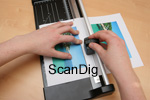
Most of the cutting machines on the market are offered with different cut lengths, so that everybody can choose the right device for the own purpose and requirements. Those who print from time to time some postcard-sized photos will barely need a cut length of 72 cm. But a family that likes to wrap some presents of big dimensions and needs therefore to cut the paper can seriously consider such a cut length. Also a hobby painter who likes to paint his water colours in the DIN A2 format can choose a bigger cutting device for this. Generally, the cutting machine is supposed to be applied universally and this is the reason why almost every device available in the market of DIN A4 (29,7 cm x 21,0 cm) format can also accomplish a cross cut of the sheet, thus have a cut length of some good 30cm.
A decisive criterion of quality of the cutting machines is, of course, the performance of the knife, no matter if it has the shape of a lever or the shape of a roll. Every housewife knows that a kitchen knife can cost a few euros in the supermarket but also that a high quality knife costs ten times more. The same applies to the cutting machines. While for the cutting of gift paper or paperboard there is no need to apply high quality knifes, in the field of photography, a high value is set on clean cut edges without fibres and fringes. At the end, a passport photo or a self-printed family photo should look clean and perfect, also the edges. The cutting machines presented on this page of Kaiser are all high quality devices, thus apt for the field of photography. The simple cutting machines for the use in the office partly do not offer a good quality of cut.
Technique, equipment and optic of the cutting machines
Not only the number of the cuts, the cut length and the amount of the material to be cut are decisive factors of choice but also the optic and the value of the device and specially of course also the cut quality and the durability of the knife. But basically, one can assume - except in case of cheap products - that a good cutting machine with a knife of a good quality is long lasting. Most of the cutting machines are self-sharpening, a thing that indicates a high durability and an easy maintenance. If needed, the producer provides some replacement knifes that can normally be easily exchanged by everybody.
Apart from the fact that all cutting devices have a basic surface, the so-called editing table for the material to be cut, hey strongly differ from each other. What is important for every cutting device is, beside the stable base plate, a preferably wide variety of format markings for the common sizes of paper, films or photographies. These should be an addition to the scales that are, as a matter of course, accurately arranged to the very last millimetre, either in the length and also in the width. Therewith it gets clear that not only the cut length is an essential criterion but also the width of the device, as, if the material to be cut is outstanding from the scales and the device, it will not be possible to cut to measure in accordance to the scale. Then the cutting edge has to be drawn as a supporting line of guidance, a very laborious and time consuming matter.
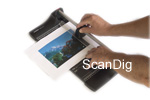
In case of the roll cutters, a guiding rail that is fixed at one side holds the die head that can be moved within the the cutting area in accordance to the determined length of construction. Due to the cutting roll it is possible to cut in both directions. The extremely sharp knife is located in the covered die head in the form of a ground roll that, while it is moved, rotates and pushes the the cutting material against the lower knife (the sharp edged plating) and splits it respectively.
Thereby, the quality of the so-called pressure plate (and/or the pressure technique of the slitter carriage on it) with which the material to be cut is fixed during the cutting procedure is not unessential. In case of those very delicately precise cuttings or slip danger, it should be built in a way that one can 100% clamp the material by the additional pressure of the hand. Most of the times, the pressure plates are transparently made in order to be able to see the cutting line perfectly. Meanwhile, the roll cutters and their construction have to fulfil some clearly stricter safety requirements, so that there is no risk of injury during the common use. But one still has to be aware of the fact that it is an extremely sharp tool and should take care never to touch neither the lower knife nor the cutting roll.
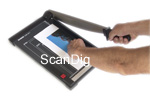
Contrary to the roll cutter, the lever cutter has - as the name already says - a big knife shaped as a sword that is converted to a lever by a hinge-joint that is firmly fixed to the cutting plate and that always has to be opened previously to the cut. Contrary to the idea of finding an extremely sharp blade, actually the knife primarily has an extremely sharp side edge that, together with the lower knife at which the blade is absolutely accurately directed, squeezes out the cutting material (similar to the system of the scissors). In cardboard and paper, this results in a very clean cut with the advantage of being able to work also some thicker materials.
Those simple and cheap lever cutters cannot compete with the cutting quality and the accuracy grade of the roll cutters. Also in the case of the leaver cutter, the pressure plate, in this case called hand pressing rail, plays a decisive role in the fixation of the cutting material. As the sharp edges of this construction are more exposed, with its angulate construction, the pressure plate provides some safety to the hand that is not used for cutting but for the fixation. What has to be secured is that the cutting knife, when opened, should not fall down by itself, and here, one also should not touch the sharp edges.
Generally it can be said that the bigger the cutting machines are, the more valuable they can be considered to be, as they have to have a certain stability for a certain length in order to guarantee a clean cut. But the individual introduction of the different cutting machine models that will follow will show that also the smaller cutting machines can provide a quality that is more than acceptable.
Kaiser safety cutting machine easy cut
The cutting machine easy cut is a roll cutter that is available in two different lengths. While easy cut 1 offers a cutting length of approximately 32 cm with a maximum cutting height of 1 mm, easy cut 2 offers a cutting length of 45 cm and a possible cutting height of 0,8 mm.
We had a deeper look into the shorter version easy cut. The nice design in conjunction with an elegant colour outstands first. The device is contained in black plastic, the cutting plate (the cutting table) is made of stable metal.
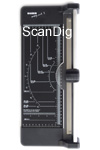
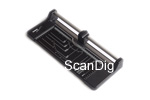
From both sides, the plastic case serves as a rectangular stop. The guiding rail made of aluminium as also the transparent rail that, with an elegant swing, runs wider in the centre (for additional pressing of material with the hand apart from the automatic contact pressure) complete the attractive appearance. The cutter roll is savely hidden under the guiding head that is very handy due to the fluting, the spring mechanism in the cutter head provides a reliable guidance of the knife at the plate- and cutting edge. For the case the knife should be replaced, one has to remove the side cover of the guiding rail, take it out and one already has the knife admission in hands.
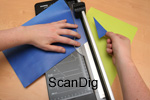
The scales and the format markings are very accurately and comprehensively arranged. Apart from the millimetre scales in length and width (31 cm/15 cm) as the same in inches (12 1/4" (length) und 5 7/8" (width)), there are also some firmly common formats of the photography field as 7 x 10 cm (3 x 4"), 9 x 13 cm (3 1/2 x 5"), 10 x 15 cm (4 1/8 x 5 7/8"), 13 x 18 cm (5 x 7") up to markings of DIN A5 and (due to the missing respective width of the device) at least the length marking of the DIN A4 format.
The grade subdivision in the centre of the cutting plate that shows a marking of up to 45 degrees in 5-degree grades in both sides direction. The instructions are available in five languages (German, Englisch, French, Spanisch, Ialian) and printed on the exterior of the packing box. In summary, a simple and elegant device with a good cutting result, also in the case of cardboards, and applicable in many ways up to the DIN A4 format(crosswards).
Kaiser safety cutting machine hobby cut
The cutting machine hobby cut is not only available in two different lengths (hobby cut 1: cut length 32 cm with 0,8 mm cutting height, hobby cut 2: cutting length of 46 cm with 0,6 mm cutting height) but also with some unusual but very interesting accessoires.
This roll cutter has also a very attractive appearance with a bezel of black plastic, the elegant cutter head on the aluminium rail and the varnished basic plate made of stable metal. The bezel can be used from both sides as a rectandular cutting stop.
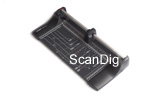
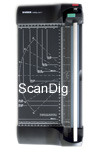
The press bar is transparent and offers enough space to assist with the hand in order to accomplish even more precise cuttings. The scale variety is huge, as it is the case of the easy cut - model. Apart from the millimetre scales in length and width (31 cm/16,4 cm) as also in inches (12 1/4"(length) and 6 1/2" (width)) there are some determined formats of the photography field as 7 x 10 cm (3 x 4"), 9 x 13 cm (3 1/2 x 5"), 10 x 15 cm (4 1/8 x 5 7/8"), 13 x 18 cm (5 x 7") up to markings of DIN A5 and (due to the missing respective width of the device) at least the length marking of the DIN A4 format. Also this model has the practical subdivision in the centre of the cutting plate that shows a marking of up to 45 degrees in 5-degree grades in both sides direction.
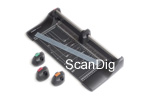
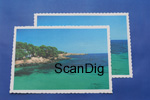
But the special feature of this device is the quick exchange of the complete cutter head with other exchange heads charged with other knifes that provide different cutting patterns. Within seconds, it is possible to remove the guiding rail, to take out the head and to replace it with a different one. Thus, there are three other knifes (already installed in the exchange heads) available that offer the deckle cut (irregular waves), perforation or zig-zag cut. Therefore, only the plastic bar has to be clamped under the cutting area providing the counter-pressure, as it is not possible to use a knife-stop as it is the case in normal knifes.

Beside the possibility to beautify the edges of photographies or print-outs, specially the option to provide the own works with a perforation is an excellent form of design. For example, self-made invitation cards, detachable addresses/telephone numbers or vouchers. The instructions are available in five languages (German, English, French, Spanish, Italian) and are printed at the outside of the packing box with an additional and illustrated instruction guide for the exchange of the cutter head. Conclusion: A robust device with a sharp knife that, due to the optional exchange knifes, offers a wide variety of applications and designs up to a format of DIN A4 (crosswards).
Kaiser safety cutting machine profi cut
As the name already says, the roll cutting machine focuses on frequent users as photographers, graphic designers, layouters or engaged creative persons that use a cutting machine frequently. The model is available in three different lengths that are denominated as profi cut 1 (Cutting length 36 cm), profi cut 2 (Cutting length 51 cm) and profi cut 3 (Cutting length 72 cm) respectively.
But it is not only the the frequency of the possible use that makes this device so professional but also the manufacture, the weight and the big cut height of 2,0 mm, with which it is possible to cut firm cardboards as for example thick photo mounting boards.
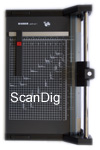
In order to have enough power for such cuttings, the device has a very solid construction, the guide rod is made of plated steel and the cutter head is, as also the roller cutter, bigger and more solid than the ones of the devices for hobby purposes. The already integrated wall mounting enables the vertical mounting. With this device, the side plastic retainers cannot be used as a stop, as then, the material to be cut would rise into the "parking position" of the big cutter head.
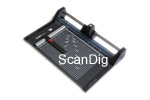
But therefore there is an extra and solid stop rail, in which it is possible to snap an adjustable and removable back stop into. This back stop is provided with magnets so that it cannot be moved by mistake on the steel cutting plate and remains on its exact positions. The advantage of this is that it enables to make numerous cuts of the same size and with a high precision. Unfortunately, the total stop is not sufficient in order to adjust the length of the DIN A4 format.
Apart from the scales in millemetre and inches (lengthways: 35 cm, 13 3/4", crossways: 30 cm, 11 3/4") there is a complete 1 cm-grid as also several format marks lengthways and crossways on the paper table (7 x 10 cm (3 x 4"), 9 x 13 cm (3 1/2 x 5"), 10 x 15 cm (4 1/8 x 5 7/8"), 13 x 18 cm (5 x 7"), DIN A5, 18 x 24 cm (7 x 9 1/2"), 20 x 25 cm (8 x 10"), DIN A4 and 24 x 30 cm (9 1/2 x 12")). It is a pitty that it is just the professional version in which this practical grid subdivision is missing.
In conjunction with the construction of the solid cutter head, the transparent pressing rail is of a real solid appearance and assisting with the hand is only in necessary case of real strong material. With such a this device it is also possible to exchange the cutter head by oneself, however it is a little more costly (loosen the screws, remove the side part). The instruction manual is in German and English language. Finally, this device is a solid and long lasting cutting machine that enables some really precise cuts up to a format that slightly slightly exceeds the DIN A4 (crosswards). Considering the otherwise very good quality of workmanship, the missing degree scale as also the back stop that is not fully sufficient for the DIN A4 format are affordable to loose.
Kaiser safety cutting machine multi cut
The multi cut cutting machine of Kaiser is our leaver cutter of the test and can be confidentally considered as a professional device. It is also available in two different sizes with cutting lengths of 33 cm, thus multi cut 1 and with a cutting length of 46 cm, multi cut 2 respectively. Both enable a cut height of 1,5 mm, a thing that enables the cutting of thicker cardboards.
A small stack of normal print paper of 10 or 15 sheets is cut immediately and simultaneously. The knife with a slight conical shape is arranged in the pivot point in such a way that when it is moved downwards, it extremely bypasses the lower knife. This provides some very precise cuts.
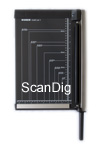
The paper table offers the ususal variety of scales and format marks of Kaiser. The lengthwards scale that is not comepletely usable due to the knife suspension offers 35,2 mm (13 7/8"), the crosswards scale measures 26 mm (10 1/4"). Her, the plastic bezel of the metal cutting plate can also not be used as a stop, but there is a stop rail specially mounted. Like in the case of the profi cut device, a magnetic back stop that provides precise results of several equal cuts, can be snapped into. What is also very helpful are the format marks for the crosswards positioned paper in the sizes 7 x 10 cm (3 x 4"), 9 x 13 cm (3 1/2 x 5"), 10 x 15 cm (4 1/8 x 5 7/8"), 13 x 18 cm (5 x 7"), DIN A5, 18 x 24 cm (7 x 9 1/2"), 20 x 25 cm (8 x 10"), DIN A4 und 24 x 30 cm (9 1/2 x 12").
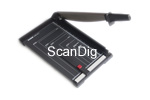
The spring-mounted hand pressing rail provides doube safety. On one side, not even a child can put the fingers under the gap of the paper feeding, on the other side, it has to be pressed in order to fix the material to be cut. Therewith, both hands are surely busy and the risk of injury is mainly discarted, as the slipping of the left hand into the cutting area is almost not possible due to the shape of the rail.
During the test, we were really enthusiastic about the precision of this device and the qualitiy of cut for such a price. The only downer is the material of the knife that is not completely stainless steel and due to this it is delivered oiled. This means that before one starts to cut paper, the knife has to be deoiled (wiping off, for example with a kitchen cloth and glass cleaner), in order to avoid grease spots on the paper. But according to our opinion, it is still a top-device with a high utility value.
Conclusion, resume
Those who want to avoid having a laborious and unprecise snipping with the scissors or with the carpet knife and attach importance to a straight and clean cut will be already fine with a simple cutting device. Kaiser-Fototechnik offers either for beginners as also for engaged users different models that are available in different lengths, depending on the individual requirements.
We have been convinced on the handling and the quality of cut of each one of the tested devices. Finally, the most important thing is a precise and clean cut. This works with the model for beginners easy cut as well as with a model for professionals as profi cut or multi cut. Specially outstanding are the different exchange knifes of hobby cut, the surprisingly precise knife guiding of multi cut and the very good automatic pressure of profi cut that enables a fast, precise and uncomplicated working. Thus, there is something for everyone.
Back to the index hardware tests
|
 |